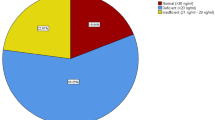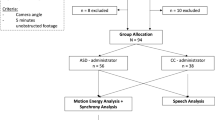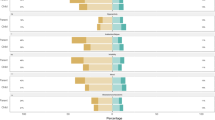Abstract
Background
The Warner Initial Developmental Evaluation of Adaptive and Functional Skills (WIDEA-FS) is a 50-item, criterion-specified questionnaire that assesses a child’s adaptive skills in everyday context and can be used in high-risk follow-up settings to identify risk for adverse neurodevelopmental outcome. Our aim was to validate the WIDEA-FS by comparing a sample of typically developing children to children with special health needs and to compare results to the Capute Scales, which include domains of including both the Cognitive Adaptive Test (CAT) and the Clinical Linguistic and Auditory Milestone Scale (CLAMS).
Methods
Six hundred and sixty children (typically developing and having special healthcare needs) aged 0–36 months completed the WIDEA-FS, the CAT, and the CLAMS assessments.
Results
Children with special health needs scored significantly lower on the WIDEA than those with typical development. WIDEA-FS subscales were significantly associated with the CAT (WIDEA-FS self-care 0.87, social cognition 0.89) and the CLAMS (WIDEA-FS communication 0.96, social cognition 0.92) tests.
Conclusions
The WIDEA-FS has concurrent validity with the CAT and CLAMS and construct validity in that children with special health needs have significantly poorer performance on the WIDEA-FS than children with typical development.
Impact
-
The WIDEA-FS demonstrated both construct validity and concurrent validity with the Capute Scales, including the Cognitive Adaptive Test (CAT) and the Clinical Linguistic and Auditory Milestone Scale (CLAMS).
-
This is the first study to validate the use of the WIDEA-FS in children with typical development and children with special healthcare needs.
-
The WIDEA-FS is a quick and valid checklist that can be used to assess neurodevelopmental functioning during daily activities in typically developing children and those at risk for neurodevelopmental differences.
Similar content being viewed by others
Log in or create a free account to read this content
Gain free access to this article, as well as selected content from this journal and more on nature.com
or
References
Horbar, J. D. et al. Trends in mortality and morbidity for very low birth weight infants, 1991-1999. Pediatrics 110, 143–151 (2002).
Lemons, J. A. et al. Very low birth weight outcomes of the National Institute of Child health and human development neonatal research network, January 1995 through December 1996. Pediatrics 107, e1 (2001).
Doyle, L. W. & Victorian Infant Collaborative Study. Evaluation of neonatal intensive care for extremely low birth weight infants in Victoria over two decades: I. Effectiveness. Pediatrics 113, 505–509 (2004).
Marlow, N., Wolke, D., Bracewell, M. A., Samara, M. & Group, E. P. S. Neurologic and developmental disability at six years of age after extremely preterm birth. N. Engl. J. Med. 352, 9–19 (2005).
Vohr, B. R. & Allen, M. Extreme prematurity-the continuing dilemma. N. Engl. J. Med. 352, 71–72 (2005).
Wang, Q. Disability and American families: 2000. Bulletin 62, 21–30 (2005).
Msall, M. & Park, J. in Neurodevelopmental Disabilities: Clinical and Scientific Foundations (ed. Hart, H. M.) 27–42 (Mac Keith Press, 2009).
Sparrow, S. S., Cicchetti, D. & Balla, D. A. Vineland Adaptive Behavior Scales (Springer, 1984).
Bayley, N. Bayley Scales of Infant and Toddler Development (The Psychological Corporation, 2006).
Ottenbacher, K. J. et al. Functional assessment and care of children with neurodevelopmental disabilities. Am. J. Phys. Med. Rehabil. 79, 114–123 (2000).
Duffner, P. K. et al. Developmental and functional outcomes in children with a positive newborn screen for Krabbe disease: a pilot study of a phone-based interview surveillance technique. J. Pediatr. 161, 258.e1–263.e1 (2012).
Mulkey, S. B. et al. Neurodevelopmental abnormalities in children with in utero Zika virus exposure without congenital Zika syndrome. JAMA Pediatr. 174, 269–276 (2020).
Mulkey, S. B. et al. Erythropoietin and brain magnetic resonance imaging findings in hypoxic-ischemic encephalopathy: volume of acute brain injury and 1-year neurodevelopmental outcome. J. Pediatr. 186, 196–199 (2017).
Gonzalez, D. E. M., Juul, S. E., Mathur, A. M., Van Meurs, K. & McKinstry, R. C. Placental pathology and neonatal brain MRI in a randomized trial of erythropoietin for hypoxic-ischemic encephalopathy. Pediatr. Res. 493, 6 (2019).
Hoon, A. H. Jr, Pulsifer, M. B., Gopalan, R., Palmer, F. B. & Capute, A. J. Clinical adaptive test/clinical linguistic auditory milestone scale in early cognitive assessment. J. Pediatr. 123, S1–S8 (1993).
Capute, A. J., Shapiro, B. K., Wachtel, R. C., Gunther, V. A. & Palmer, F. B. The Clinical Linguistic and Auditory Milestone Scale (CLAMS). Identification of cognitive defects in motor-delayed children. Am. J. Dis. Child. 140, 694–698 (1986).
Msall, M. E., DiGaudio, K. M. & Duffy, L. C. Use of functional assessment in children with developmental disabilities. Phys. Med. Rehabil. North Am. Clinics 4, 517–527 (1993).
Voigt, R. G. et al. Concurrent and predictive validity of the cognitive adaptive test/clinical linguistic and auditory milestone scale (CAT/CLAMS) and the Mental Developmental Index of the Bayley Scales of Infant Development. Clin. Pediatr. 42, 427–432 (2003).
Rogers, B. et al. Cystic periventricular leukomalacia and type of cerebral palsy in preterm infants. J. Pediatr. 125, S1–S8 (1994).
Capone, G. T., Goyal, P., Grados, M., Smith, B. & Kammann, H. Risperidone use in children with Down syndrome, severe intellectual disability, and comorbid autistic spectrum disorders: a naturalistic study. J. Dev. Behav. Pediatr. 29, 106–116 (2008).
Rogers, B. T. et al. Neurodevelopmental outcome of infants with hypoplastic left heart syndrome. J. Pediatr. 126, 496–498 (1995).
Wachtel, R. C., Tepper, V. J., Houck, D., McGrath, C. J. & Thompson, C. Neurodevelopment in pediatric HIV infection. The use of CAT/CLAMS. Clinical Adaptive Test/Clinical Linguistic and Auditory Milestone Scale. Clin. Pediatr. 33, 416–420 (1994).
Hensch, T. K. & Bilimoria, P. M. Re-opening windows: manipulating critical periods for brain development. Cerebrum 2012, 11 (2012).
Capute, A. J. & Accardo, P. J. The infant neurodevelopmental assessment: a clinical interpretive manual for CAT-CLAMS in the first two years of life, part 1. Curr. Probl. Pediatr. 26, 238–257 (1996).
Acknowledgements
This project required a multidisciplinary network of developmental pediatricians, pediatric nurse practitioners, pediatric physical, occupational, and speech language therapists, early child educators, and community pediatricians. We are grateful to Nancy Lyon, Kim McKernan, and James Roistacher for community outreach and engagement. This study was supported by a grant from the Children’s Guild of Buffalo. M.E.M. is also funded in part by Leadership Education in Neurodevelopmental and Related Disorders Training Program (LEND)—Illinois T73 MC11047 HRSA/DHHS.
Author information
Authors and Affiliations
Consortia
Contributions
Each author has met the Pediatric Research author requirements. C.P., K.W., J.P., C.C., and M.E.M. contributed to conception and design, analysis and interpretation of data, and drafts of the manuscript. K.M., N.L., C.P.B., B.T.R., J.R., F.A.C., and M.E.M. contributed to acquisition of data. All the listed authors contributed to revising the article for intellectual content and all authors approved the final draft.
Corresponding author
Ethics declarations
Competing interests
The authors declare no competing interests.
Consent statement
Informed consent was required for participation in this study.
Additional information
Publisher’s note Springer Nature remains neutral with regard to jurisdictional claims in published maps and institutional affiliations.
Supplementary information
Rights and permissions
About this article
Cite this article
Peyton, C., Wroblewski, K., Park, J. et al. Validity of The Warner Initial Developmental Evaluation of Adaptive and Functional Skills (WIDEA-FS): a daily activity criterion checklist for infants and toddlers. Pediatr Res 90, 1052–1057 (2021). https://doi.org/10.1038/s41390-020-01342-0
Received:
Revised:
Accepted:
Published:
Issue date:
DOI: https://doi.org/10.1038/s41390-020-01342-0



